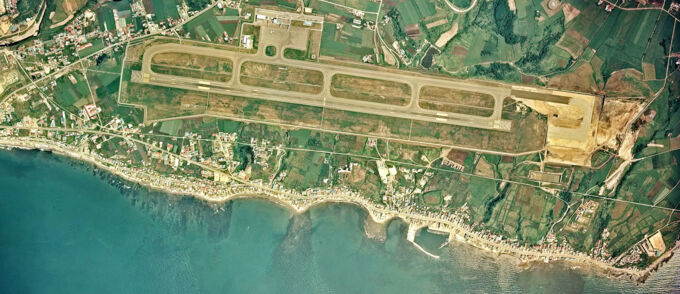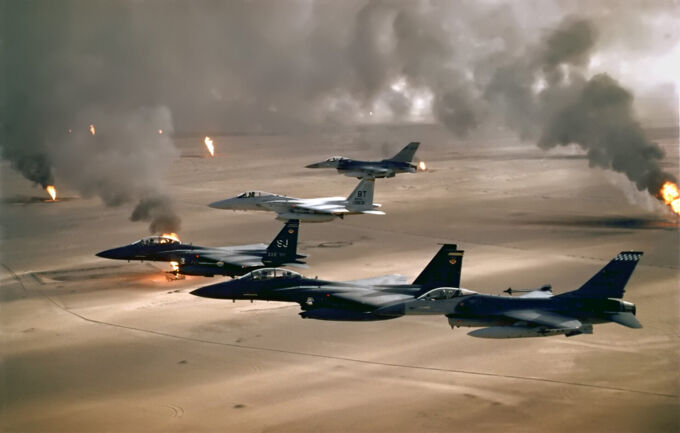The F-15 Eagle was made to combat the growing national threat of the USSR, and the MiG-25 Foxbat. The F-15 can carry a variety of useful munitions, and is still being used today by the US military. To this day, there isn’t a clear date for when all F-15s will retire.
Growing Communist Threat
In 1967, the USSR revealed the MiG-25 Foxbat at the Domodedovo Airfield in an airshow. It looked to be a perfect air superiority fighter, designed for high speeds and altitude, and dangerously similar to the F-X Program, which haven’t even started yet. This caused serious concern within the US, so the Air Force desperately needed a new top of the line fighter jet to not only combat the MiG-25, but to also replace the aging F-4 Phantom II.
There were 5 companies in the contract to build this new jet.
- McDonnell Douglas (F-15)
- NAW North American Rockwell (NA-335)
- Fairchild Republic (N/A)
- General Dynamics (F-16)
- Vought (most dimensions not released to public)
Vought’s proposal was too heavy like other earlier models, and at that time Vought was better known for naval fighters like the A-7 and F-8. They were also losing in cutting edge fighters compared to other companies like McDonnell Douglas and General Dynamics.
General Dynamics had prior success with the F-111 Aardvark program, so they submitted a design which was the F-16. It was slow with limited cockpit visibility compared to the MiG, and with prior experience of these type of jets in the Vietnam war the F-16 wasn’t suitable for dogfighting in this situation. It would later win the Lightweight Fighter competition.
Fairchild Republic’s design was unknown and not released to the public.
The NAW NA-335 was too large and heavy, which made it a visible target, even from far away. It sacrificed major components, like maneuverability and acceleration, which was needed to fight the Foxbat especially in close-quarters. It was abandoned in early stages.
The F-15 turned out to be the winner (1969) because of its speed, maneuverability, and at the time an advanced radar. Less than 5 years later, on July 1972, the F-15A prototype went on its first maiden flight. In 1976, the first F-15A’s entered service for the USAF. It had 2 Pratt and Whitney F100 engines for very fast acceleration and speed. A GAU-7 25mm gatling gun was proposed, but due to development problems, the M61 Vulcan 20 mm was chosen instead.
Soviet Panic
The Foxbat started looking obsolete compared to the F-15. The Foxbat’s design features were still heavily classified, but would be revealed soon.
September 6, 1976: Viktor Belenko was flying his MiG-25PU Foxbat on a training exercise in Vladivostok. He defected and landed at Hakodate Airport, Japan, breaking his front landing gear. The US thoroughly inspected it, and they realized it wasn’t as good as it looked.
The Foxbat wasn’t maneuverable at all, and its big wingspan was just to get the heavy airplane off the ground. It was underpowered, and lacked up to date avionics like look down/shoot down radar. It was now the Soviets' turn to panic.
Later Development
In 1978, the F-15C and F-15D entered production. They had the PEP-2000 (Production Eagle Package), which added 2000LB of additional internal fuel, and a maximum takeoff weight of 68000LB. Its APG-63 radar helped it detect jets from up to 56nmi away. Other additions featured stronger landing gear, arrestor hook, and an OWS (Overload Warning System) which allowed the pilot to pull up to 9Gs.
MSIP Program (MultiStage Improvement Program)
In February 1983, MSIP Program was initiated. The first MSIP F-15C was produced in 1985. It featured a Programmable Armament Control Set which allowed usage of later models of the AIM-7, AIM-9, and AIM-120. MSIP also added improvements to the ALR-56C radar warning receiver and ALQ-135 countermeasure set.
Dual-Role Fighter
The early models of the F-15 were focused on air superiority, and it worked. However, the US saw an opportunity with the F-15 and turned it into a multi-role fighter. The first multi-role F-15 was the F-15E. It had an APG-70 radar, LANTIRN targeting pod, and fly-by wire controls. It was modified to be equipped with air-to-ground ordnance like bombs, guided bombs, etc.
Service
The first F-15 kill was by an IAF (Israeli Air Force) ace in 1979. It proved successful, as in the Lebanon war, 41 air kills were achieved by Israeli F-15As. Its first strike (ground) mission was in October 1, 1985 during Operation Wooden Leg. 6 F-15Ds attacking a PLO Headquarters located in Tunis. The first American combat use of the F-15 was in Operation Urgent Fury used for skirmishes.
Anti-Satellite Bird
From 1984 to 1986, F-15As were used for anti-satellite trials. The center hardpoint was modified to carry a singular ASM-135 ASAT designed by Vought. 3 trials were conducted, with the third one being successful. The only time a satellite has been destroyed by a jet in aviation history, by Wilbert D “Doug” Pearson.
Gulf War
There were 2 versions of the F-15 used during the Gulf War, being the F-15C and F-15E. The C was used for air superiority, and the E was used for ground missions. The performance of the C was outstanding, and out of 40 total air kills, the C shot down 36. The E conducted precision-strikes throughout the battlefield, like the SCUDS and GBU-39.
Countries
The main operator of the F-15 is the US. Israel operates the A, B, C, D. In-game, Israel has the I Ra’am, Baz, and the Baz Meshupar. Japan has access to the J, and is producing the F-15DJ by Mitsubishi with license. Saudi Arabia has the C and D, as of 2024.
Accidents
May 1, 1983: Israel F-15D did a mid-air collision with an A-4 during training exercises, no injuries.
March 26, 2001: 2 USAF F-15C crash near Ben Macdui over Scottish Highlands during low-flying training. 2 dead.
November 2, 2007: F-15C crash over St. Louis, Missouri from structural failure. No injuries.
Specifications
| Model | Country | Seating | Specialty | Year | Radar | Important Weapons | Notes |
| A | US | 1 | Air | 1972-2009 | AN/APG-63 | AIM-7, AIM-9 | Original |
| B | US | 2 | Air | 1973-2025 | AN/APG-63 | AIM-7, AIM-9 | Trainer of A |
| C | US | 1 | Air | 1980-2025 | AN/APG-70 | AIM-7, AIM-9, AIM-120 | Improved avionics, range |
| D | US | 2 | Ground | 1980-2026? | AN/APG-70 | AIM-7, JDAM | Trainer of E |
| E | US | 2 | Ground | 1989-2030? | AN/APG-70 | JDAM, Paveway, AGM-130 | Multirole |
| EX | US | 2 | Both | 2024-2050? | AN/APG-82 | AIM-120, JDAM, SDB | Latest model |
| J | JPN | 2 | Air | 1981-???? | ? | AIM-9, AAM-3 | JPN-Build |
| DJ | JPN | 2 | Air | 1981-???? | ? | AIM-9, AAM-3 | Trainer for J |
| I Ra’am | IL | 2 | Ground | 2003-???? | ? | JDAM, Popeye | Optimized E model for Israel |
| K Slam Eagle | KOR | 2 | Ground | 2002-2060? | ? | JDAM, AGM-84 | Fit for KOR strike missions |
| QA | QTR | 2 | Both | 2021-??? | AN/APG-82 | AIM-120, JDAM | Advanced Qatar Variant |
| SA | SAU | 2 | Both | 2021-??? | AN/APG-63 | AIM-120, JDAM | Saudi |
Conclusion
The F-15 established itself in aviation history as one of the most successful aircraft. It originates from the Cold war to combat the Soviet MiG-25 threat all the way to present day, where it will still be used for decades to come. It has established unmatched air and ground superiority throughout its use. As it evolves still remains as one of the best aircraft in history.
Sources
- https://en.wikipedia.org/wiki/McDonnell_Douglas_F-15_Eagle#Design
- https://en.wikipedia.org/wiki/McDonnell_Douglas_F-15E_Strike_Eagle
- https://en.wikipedia.org/wiki/Boeing_F-15EX_Eagle_II
- https://en.wikipedia.org/wiki/AN/APG-63_radar_family
- https://en.wikipedia.org/wiki/Defection_of_Viktor_Belenko
- https://www.af.mil/



